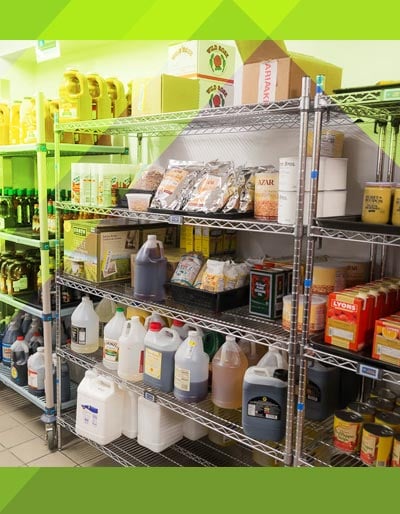Cleaning your back-of-the-house operations may not seem like a big deal post-COVID-19 – if you don’t have an open kitchen, the customers don’t go back there, right? Well, you should rethink that idea. It doesn’t take much for a snoopy customer to gain access; something as simple as a photo taken through the window of a traffic door can easily be spread through social media and other online forums.
More importantly, think of this as an opportunity to show your customers just how much sanitation and customer safety is a priority for you and your restaurant. I’m sure you have social media accounts, probably a website. Grant your customers electronic access to these back-of-the-house spaces and show off just how clean your kitchen is! Don’t fool yourself by thinking that patrons won’t be researching where their next meal will be when we come out of this thing. Show them NOW the strides you are taking to ensure their safety. You can start building and reinforcing your core customer base right now.
But first you need to CLEAN THAT KITCHEN! Luckily, we have a little time.
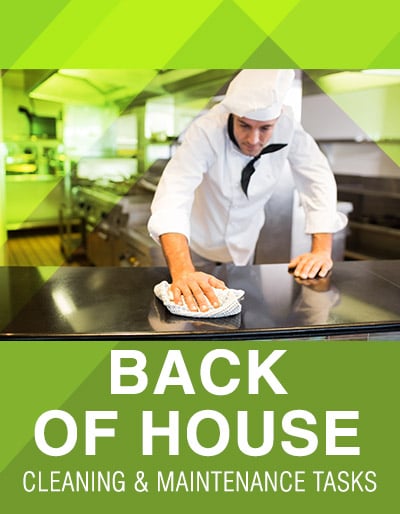
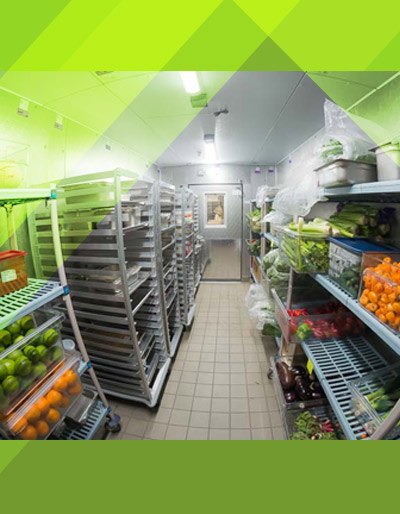
Cleaning your Walk-In Coolers and Freezers
Alright, time for a deep clean and reorganization of this essential back-of-the-house area. It’s best to do these one at a time since this could be a full day’s work, depending on the size of your coolers. Typically, it’s hard to find the time to deep clean your coolers since during normal business you need to have constant access to each. Now that production is down, it might be the perfect time. To preserve inventory, you can temporarily move product to the other cooler. For example, when cleaning your cooler, you could move your stock over to the middle of the freezer for a while to prevent spoiling. Don’t leave it overnight, or you will clearly freeze some product.
For almost all of your non-porous surfaces, QA Sanitizer is an effective cleaning solution that’s CDC-approved.
- Roll out your pan racks, remove the pans, then clean & sanitize the racks. Inspect and lubricate the casters.
- Pull product out of and off the shelving.
- Inspect all your plastic containers for cracks, dings, and chipping. Might be easier to replace those now than potentially clean up a mess later.
- Clean and sanitize all shelving.
- Replace any bent, mangled, or rusted shelves. Check the shelf clips and anything you have that might attach to the shelving units for security.
- Clean the walls behind the shelving.
- Scrub the floor. Now that all the product is out you can get into those corners and give them a deep cleaning.
- Clean the fans. Turn the power off and unplug, then clean the fans inside the unit.
- Clean the ceiling if anything has exploded and stuck to it.
- Inspect the light bulb and clean the bulb cover.
- Check the door gaskets and clean the window (if you have one).
- Inspect the inside release push, latch, and handle. Tighten, lubricate, or replace if needed.
- Inspect and lubricate the door hinge.
- Re-think your organization.
- Now that you have everything out, does it make sense to replace the product in different areas? What sells more, what can be moved a little deeper?
- Consider increased accessibility for commonly-used items.
- Create shelf and wall signage to make sure the space allocated for common products doesn’t get quickly covered in the middle of the rush.
- With your reorganization plan in place, replace the product in your cooler and marvel at how clean and organized it is!
- Repeat with your other boxes.
Clean Your Cookline Hood
Typically, it’s difficult to find time to deep clean your cookline. Everything is either hot and cooling down, or cold and needing to be used in about an hour, no time to clean. Well, maybe now’s the time, huh? Save yourself a potential fire hazard and improve the breath-ability and ventilation of your back-of-the-house area by deep cleaning your hood and filters.
- With the equipment off and cool, remove all the filters.
- It might not be a bad idea to pull out your equipment at this point so you can do a really deep clean on the equipment and the hoods.
- If that’s not possible, be careful using step ladders or consider getting a baffle-boss (these things are actually really handy for regular cleaning).
- Soak and clean the filters. Take a little more time than a regular cleaning to ensure a thorough clean. You have the time now.
- Up in the hood, clean out the grease in the tracks where the filters sit, then clean out the grease trough.
- Wipe down all the surfaces up in the hood.
- Wipe down Ansul System lead lines and nozzles.
- Check the tags on the system just to double check inspections are current.
- Outside the building, if accessible, check the exterior fans, covers, and the wall. De-grease and clean.
- Pressure washer might come in handy here.
- You can use that pressure washer to deep clean your equipment too!
- Pressure washer might come in handy here.
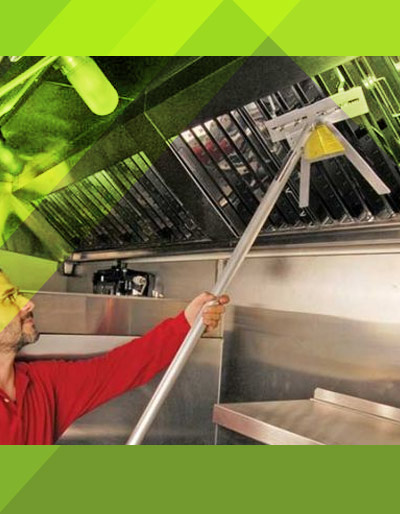
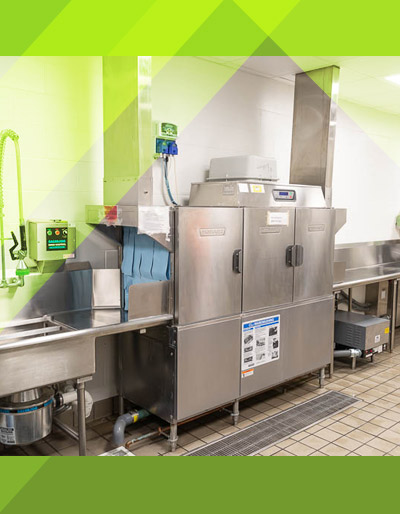
Cleaning Your Back-of-the-House Dish Room (or Corner)
Clean the cleaner, am I right? This is the space that primarily plays the roll of maintaining your sanitation. Does it look sanitary? It should. If not, it can pretty easily. Just start here:
- Clean your dish machine. The dish machine cleans everything else, don’t forget to clean this key tool in your overall sanitation.
- Check your service manual for whatever self cleaning capabilities it may have for inside the chamber.
- Inspect the sprayers, remove any debris clogging the arms.
- Deep clean the slop screen and housing for it.
- Clean around all your chemicals and booster heater below.
- Clean underneath the drain boards and basins.
- Clean the disposal.
- Clean the pre-rinse arms.
- Clean the walls behind everything and re-silicone the tables and sinks.
- Inspect and clean your dish racks.
- Clean all the shelving.
- Clean your pots & pans.
- Clean the daily use pots. Yes, the black carbon build-up will come off.
- Consider a product like Carbon-Off to save on the elbow grease.
- Wire blast your saute pans.
- Clean and inspect all your storage containers.
- Replace anything with cracks or chips.
- Inspect your dinnerware and flatware too.
- Replace anything cracked or bent.
- Clean the daily use pots. Yes, the black carbon build-up will come off.
- Clean all the walls.
- Clean and inspect the floor drain
- Deep clean the floor.
Clean Your Cookline
Alright, if you can afford to have everything off now, it’s the perfect time to deep clean your back-of-the-house equipment. This might not be the most fun project, but a deep clean now will make it way easier to maintain the cleanliness once business ramps back up. Check your manuals for specific cleaning instructions for each piece. If you’ve lost those, no worries, somebody will have them online. If not, we can likely track down information for you, we know all the right people!
For equipment that does not contain sensitive electronics, you may consider using a pressure washer for deep cleaning the components. This will help strip away layers of grease that have accumulated over time. If you can pull your equipment away from the wall for cleaning, all the better. Thoroughly clean the backs of the equipment and the walls and floor where they were. If you can’t move the equipment, be sure to get underneath the equipment by whatever means available. Partially sliding equipment (be careful of your gas lines), then moving it the opposite way to uncover more floor space may work.
We have a number of cleaning products to help with this process. FOG has proven a great general cleaner for basically all of your equipment. Use it to boil out the fryers, clean the ovens, spot clean the range, etc. For deeper cleaning and carbon build up problems, Carbon-Off is our go-to.
After a deep cleaning, consider a coat of Brite Shine to put that final polish on the cookline to make it “camera-ready”. Then take lots of pictures of your shiny cookline to share on your website and social media.
Up High and Down Low – These are the main areas that don’t get cleaned during our regular back-of-the-house routines. Address these now. Look on top of everything and clean it. On top of your plate shelves, microwave shelves, salamander, etc. Low: below everything, under every piece of equipment. Equipment stand bottom shelving, etc. Change your perspective by getting on a step ladder or on your knees. You’ll find plenty to clean.
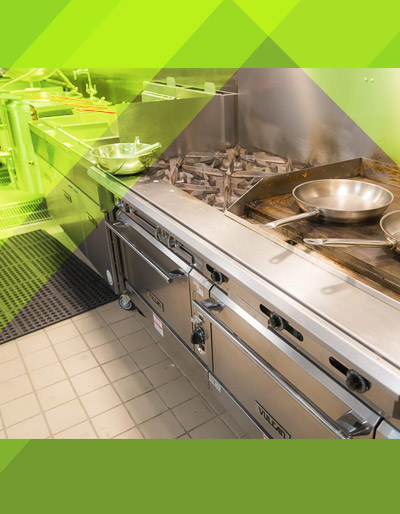
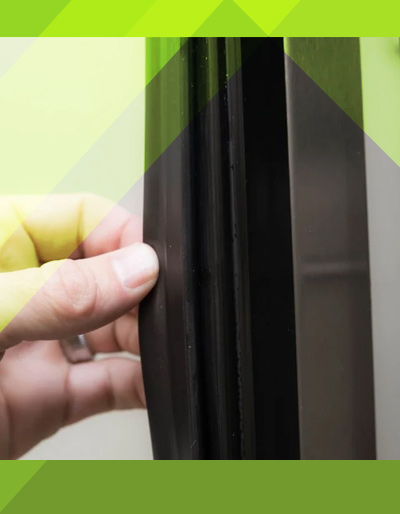
Clean your Back-of-the-House Reach-Ins, Undercounter Coolers, Prep Tables, and Chef’s Bases
The process here is pretty much exactly the same as the walk-in coolers, just on a slightly smaller scale. You can move the contents into your super clean walk-ins while you do it.
- Take everything out, inspecting all your containers and replacing if faulty.
- Clean every surface inside the box.
- Inspect any drain lines.
- Inspect and clean all shelving.
- Consider re-configuring the space for improved efficiency.
- Check the door gaskets.
- Clean and lubricate the hinges.
- Wipe down and polish the exterior.
- Clean the condenser coils.
- Clean underneath the units.
- Label everything with more permanent labels (get yourself a label maker).
- Repeat for every piece of refrigeration equipment in your kitchen.
Clean Your Pantry and Dry Goods Storage
Now is your opportunity to concentrate on the “catch-all” that has become your back-of-the-house dry storage area. Take a good look around and identify anything that doesn’t belong. This is supposed to be your dedicated storage area for the back-stock of dry goods you use for your menu. Why is last month’s point of sale promotional beer cutout of a celebrity athlete wedged between your ingredient bins and flour sacks? Remove whatever doesn’t belong, then remove everything in a section to deep clean.
Clean the shelving, the walls, the floors, etc. You should be pretty used to the routine by now. Inspect and replace anything broken. Clean any storage container that needs it. Consider how everything is organized. Is it optimized for efficiency? Is it too cramped? Maybe now is the time to consider installing track shelving to take better advantage of the space.
Label things. Having a dedicated place for the most commonly-used ingredients is the best way to increase efficiency. Take the time now to establish those locations and label them so you stick to it. Wouldn’t it be wonderful if you never again had to hunt for the soy sauce?
Look high, look low, and clean everything you don’t have a recent memory of cleaning. A cleaning pail with a spray bottle holder built in can make cleaning these areas easier.
